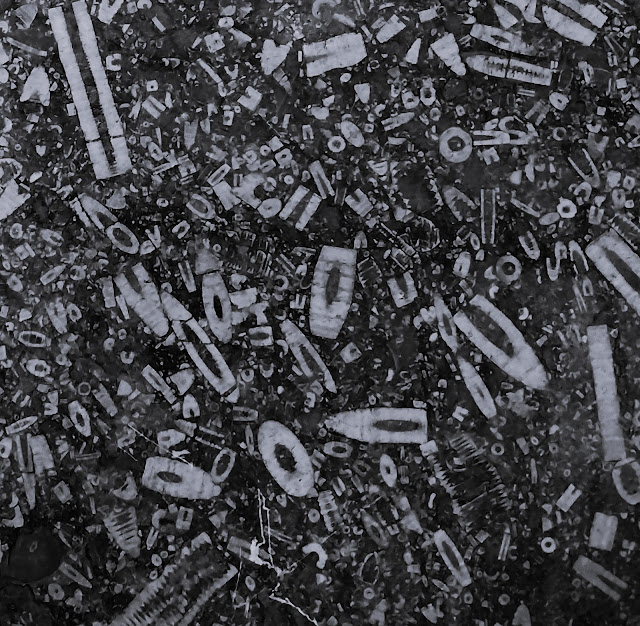In general, people don't really expect floors to be interesting but, just sometimes, you come across something like this. Before I tell you about this stone, and the fossils in it, I'll tell you about the day I took this photo.
It was a Sunday, and for me it was a Red Letter Day. I have a bucket list, and one of the items on it was to hear Mussorgsky's 'Pictures at an Exhibition' live. If I could hear 'Night on the Bare Mountain' at the same performance, that would be a real bonus. The Philharmonia Orchestra were performing both at the Royal Festival Hall on the South Bank, London, and Steven Isserlis was the soloist for Kabalevsky's Cello Concerto number 2 in addition. The whole concert was a real treat and well worth the trip to London.
I'd got there early - a couple of hours early. Deliberately. That allowed for rail delays and gave me time to buy lunch (this was an afternoon performance). It also gave me time to look at the floor - there is some refurbishment going on at the Hall at present, so there were was nobody milling around where I was admiring the said fossils and trying to get a decent photo of them with my mobile phone (it's a Samsung A23, if you're interested and you want to look up details of its cameras). I was half-aware that there was somebody nearby, and he came over to ask me about the photos I was taking. If you know me, you know that means I'm going to go into some detail with an equal amount of enthusiasm. After he introduced himself, he asked to take my photo - he is a very talented portrait photographer, and I'm really looking forward to seeing the result. He was shooting on actual film! We then spent a good few minutes looking at the floor and in my case, trying to take a decent-ish photo of it. I am pleased to say that Gavin, as I learned his name is, was as enthusiastic about the crinoids as I was, especially when I showed him a photo of an extant species. I'd be interested to see the photos of them he took. We swapped Instagram details so I no doubt will.
Coming back to the photo: Quite apart from the fact that I'm a tad arthritic nowadays, taking a photo of a polished slab is a s*d because the camera tries to focus through the surface rather than on it, and also the surface is worn so that the edges of the fossils are no longer crisp and distinct when you really zoom in to them.
Having made my excuses for this photograph:
This is Derbydene Stone, a limestone from Cromford in Derbyshire (I didn't know that when I visited Cromford many years ago!). It is full of the stems and ossicles of crinoids (sea lilies). These are animals in the same family - echinoderms - as sea urchins and starfish.
What is a amazing about these crinoids, though, is their age. They, and the stone they are preserved in, date back more than 330 million years to the Lower Carboniferous Period, long before the evolution of dinosaurs and mammals. In fact, when T. rex was learning that that bright flash was really bad news, these animals had already been fossils for 264 million years. We're way closer in time to T. rex, at 66 million years, than T. rex was to these crinoids.

Comments
Post a Comment